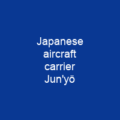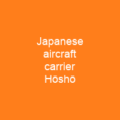Hiyō: A Luxury Liner’s Turbulent Journey into War
Imagine a grand ocean liner, built for luxury and comfort, sailing the vast blue seas with its passengers enjoying every amenity. But what if this luxurious vessel was suddenly transformed into something far more sinister? That’s exactly what happened to Hiyō, the lead ship of her class, which began life as a passenger liner in 1939 and ended up as an aircraft carrier for the Imperial Japanese Navy in 1941. How did this transformation occur, and what was its fate?
The Conversion from Luxury to Warship
Before her conversion, Hiyō was designed to carry 890 passengers and 1,224 crew members, with a length of 220 meters and a displacement of 24,150 tonnes. Her initial air group consisted of 12 Mitsubishi A5M ‘Claude’ fighters, 18 Aichi D3A ‘Val’ dive bombers, and 18 Nakajima B5N ‘Kate’ torpedo bombers. But as the war progressed, her armament was revised to include 21 Mitsubishi A6M Zero fighters and reduced numbers of other aircraft.
Double Hull and Armament
Hiyō had a double hull with Ducol steel protection for machinery spaces. Her primary armament included 12 x 12.7 cm Type 89 guns in twin mounts and eight triple mounts for 2.5 cm Type 96 light AA guns, with additional armaments added later. The ship also featured several early warning radar systems to enhance her defensive capabilities.
Commissioning and Early Assignments
Hiyō was launched on June 24, 1941, and commissioned on July 31, 1942, with Captain Akitomo Beppu in command. After commissioning, she joined the Second Carrier Division of the 1st Air Fleet and became flagship of Rear Admiral Kakuji Kakuta on August 12.
Operations Against American Forces
Hiyō‘s first major operation was against American forces in the Guadalcanal area. On October 16, she launched attacks on American transports off Lunga Point but faced heavy resistance from Marine fighters. A fire reduced her top speed, and she returned to Truk for repairs.
Continued Operations
After repairs, Hiyō continued operations against Allied forces in the Solomon Islands and New Guinea. In early April 1944, her air group was detached to participate in Operation I-Go, a land-based aerial offensive. On April 7, her aircraft formed part of the third wave of attacks on Guadalcanal.
Final Days
In late March and early April, Hiyō‘s aircraft made several series of attacks against Allied forces in New Guinea, including Oro Bay and Port Moresby. On April 14, she was involved in an attack on Milne Bay with claims of downing three Allied aircraft without loss.
The Battle of the Philippine Sea
On June 7, Hiyō was torpedoed by a US submarine off Miyakejima but managed to return to Japan. She conducted training exercises in the Inland Sea until May 11 and then sailed for Tawi-Tawi in the Philippines.
The Final Battle
On June 13, 1944, Hiyō was part of the Japanese fleet that encountered Task Force 58 in the Philippine Sea. She launched air strikes but failed to find American ships. The next day, she was discovered by Americans and subjected to an air strike which caused significant damage.
Conclusion
The story of Hiyō is a testament to the unpredictable nature of war. From a luxurious ocean liner to an aircraft carrier, her journey was marked by both luxury and conflict. Her final moments in the Battle of the Philippine Sea serve as a poignant reminder of the harsh realities of naval warfare during World War II.
Hiyō’s transformation from a passenger liner to a warship and its ultimate fate highlight the dynamic nature of military strategy and the impact of technological advancements on naval combat. Her story is a crucial part of understanding the complexities of maritime warfare in the Pacific theater.
You want to know more about Japanese aircraft carrier Hiyō?
This page is based on the article Japanese aircraft carrier Hiyō published in Wikipedia (retrieved on March 11, 2025) and was automatically summarized using artificial intelligence.








